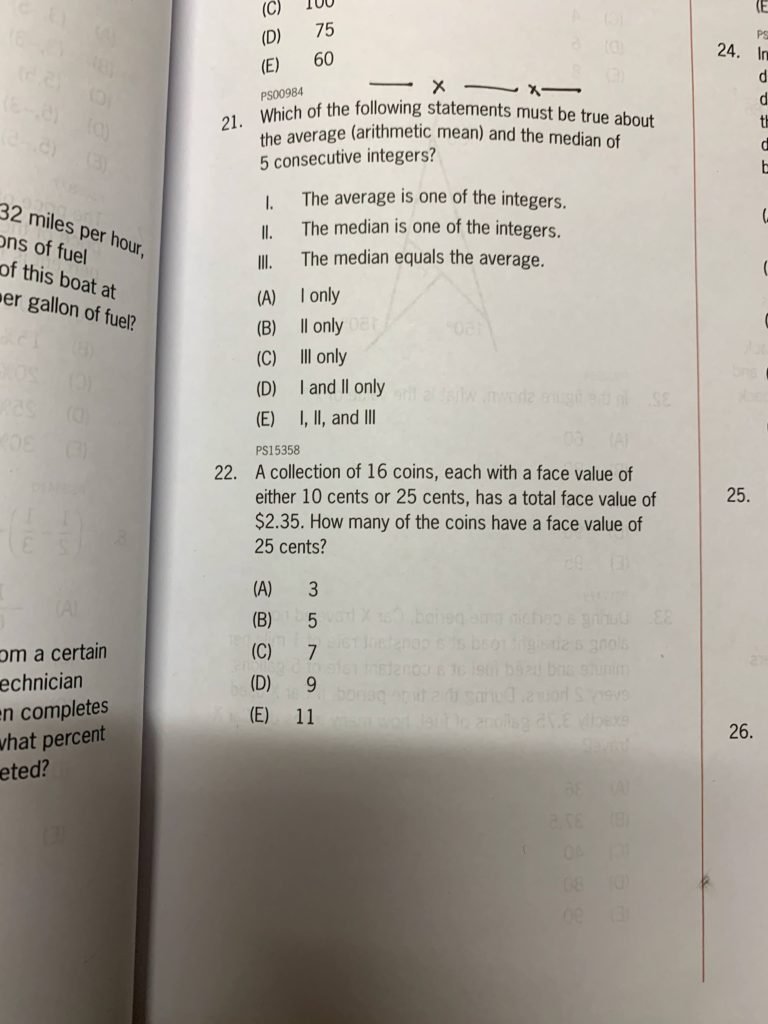This section discusses solving GMAT problem-solving section, which is a part of quantitative reasoning. Most questions in this case can be solved using basic algebra. We quickly go through a set of 10 questions. These are some of the sample GMAT Math Questions and Answers for reference!
Disclaimer: These Sample GMAT Math Questions are sourced from the Official GMAT Guide. I in no way claim to be the owner. The goal is to merely list some key questions and discuss the answer/approach to the problem.
The approach to solving the below questions is to define the variables and then writing down the equations based on the statements.
Representing Equations
- 21: This can be a tricky question. The key aspect being consecutive integers.
- But can solved using by representing the first number as a variable n.
- The rest 4 can be represented as (n+1),(n+2), (n+3) and (n+4). The sum becomes 5n+10.
- The average comes out to (n+2). This is the same as the median of the 5 consecutive integers.
- The answer is (E)

- 22: This is a straightforward algebra question. Represent the statements as equations and we are good.
- We have two variables. The 10 and 16 cent coins can be represented as X and Y. The first equation is X + Y = 16 while the second equation is 0.1*X + 0.25*Y = 2.35
- Solve this by replacing X in the second equation with the first one and we are good to go ahead.
- 1.6-0.1*Y + 0.25*Y = 2.35 which results in 0.15*Y = 0.75
- The answer is B
The 22nd question had two variables X & Y and two equations. We need as many equations as variables to be able to solve them and this is the trick behind lots of Data Sufficiency questions. Therefor, we can cannot solve a problem if the number of variables is more than the number of equations!
Units Standardisation
- 23: Nothing much different about this case than the other sample GMAT math & problem-solving questions.
- The trick here is that the statements are represented as per dozen and per 3eggs. The units are different and need to be adjusted.
- Represent everything into dozen as a unit.
- Then later multiply the difference by 5 as required.

- 24: We need to find all numbers between 1-24 which are divisible by either of 2,3 or 7.
- I solved it by writing down all the 24 numbers but can be solved in a better way.
- And crossed all those divisible by 2,3 or 7.
- This comes out to be 17 thereby the answer being 17/24.
Using Dummy Values
- 25: This is one question that requires basic knowledge about the circumference of a circle.
- The circumference of a circle is 2*pi*r where r is the radius.
- r comes out to be 25/2
- One side of the square is 25 so the perimeter is 25*4 = 100.

- 26: This question can be speeded by assuming dummy values for x, y and z. By doing so, we can quickly solve the two tricky choices of D & E
- I assumed x, y, z to be 2,3 & 4 respectively.
- The options are between D & E since the multiplication of the two largest values.
- The option turns out to be 3(2+4) or 4(2+3).
- The second value is 20 > 16 and thereby E.
Approximation
- 27: I found this question to be a bit time-consuming. Solved for it by quickly representing the numbers as a range.
- The first series can be assumed to be 1-8.
- The first set in Y goes from 5-12. Adding 4 to each number.
- The second set in Y goes from -3 to 4.
- We thereby have a complete overlap of the 8 elements.

- 28: Tricky one, can be a drain on time. We can be liberal with small values and need to get the big ones right.
- The numerator ~60 but greater than 60.
- The denominator is ~ 5. 4.86 + 5*0.03 = ~5
- Thereby we can quickly assume the value to be close to 12.
- The trick was representing 4.86 as 5 for the computation in the denominator with 0.03.
Confusing Statements
- 29: Standard algebra questions with 3 variables. The only challenge is the confusing variables in form of paperback and fiction/non-fiction.
- Quickly represent the variables as PF, PNF and HNF.
- The first equation is PF + PNF + HNF = 140.
- The second equation being PNF = HNF + 20
- The third equation is PF = 2*PNF
- The final equation is 3*PNF + HNF = 140 or 4*HNF + 60 = 140
- Re-check this answer because you can get the translation wrong in this case.

- 30: Standard algebra question. The sum is 72 aka 18*4.
- We subtract the values 3,15 and 32 from 72.
- The final value of N+1 = 22, N is thereby 21.
- Answer is C
Conclusion
All the sample GMAT math questions are based on algebra and a basic understanding of the mathematical properties of circles, triangles, squares and other aspects of geometry. To quickly move through the questions
- Write equations where ever possible.
- Be careful when translating confusing statements.
- Ensure data units are the same.
- Any missing info can be derived from properties of geometry
- When approximating, get the computation of the large numbers correct and the small ones can be rounded off.
